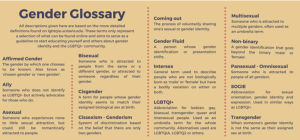5
Anka Clark; Sanne Baas; Angelina; Hannah Cool; and Min-Yao Sun
Want to Listen to This Chapter?
Copy and paste the text of any chapter into this website to listen to it while you read.
Adrienne Rich said: “When someone with the authority of a teacher describes the world and you are not in it, there is a moment of psychic disequilibrium, as if you looked into a mirror and saw nothing.” (Rich, 1986). This quote stresses the importance of inclusive education in an environment that is representative of all students. In this chapter, gender identity is taken as one of the many facets of diversity, and knowledge, skills and resources are offered for teachers or other professionals to enhance their inclusive practices.
Gender identity is an underrepresented topic in primary education, this often due to a lack of confidence relating to the selection of appropriate content delivery. This chapter aims to provide support by suggesting practical instructional approaches and topics that are relevant to young students as well as discussing possible issues that may arise. Tips for selecting suitable resources and materials will be given to create a learning environment that is fully representative of the diverse world we live in.Gender will also be discussed as a cultural construct to create an awareness of possible intercultural difficulties before concluding with suggestions for communication with concerned parents.
Throughout the chapter, many references will be made to the following terms, for which a brief definition will be provided here (Teaching Tolerance, n.d.). More vocabulary related to the topic can be found in the glossary underneath.

External appearance of one’s gender identity, usually expressed through behavior, clothing, haircut or voice, and which may or may not conform to socially defined behaviors and characteristics typically associated with being masculine or feminine.
One’s innermost feeling of maleness, femaleness, a blend of both or neither. One’s gender identity can be the same or different from their sex assigned at birth.
Not gendered, usually operating outside the male/female binary. Can refer to language (e.g., pronouns), spaces (e.g., bathrooms) or identities.
The pronoun or set of pronouns that an individual personally uses and would like others to use when talking to or about that individual. Can include variations of he/him/his, she/her/hers, they/their/theirs, among others.
